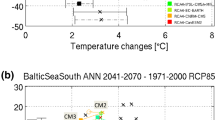Abstract
The Baltic Sea is one of the most polluted sea areas in the world. Except for different local pollution sources, the overall environmental problem is eutrophication. The eutrophic situation is caused by increased external load of nutrients during decades. Since nitrogen (N) is generally considered the main limiting nutrient for primary production in the Baltic Sea, the countries within the Baltic Sea drainage basin have agreed to reduce the anthropogenic waterborne input of N by 50% between 1987 and 1995. Furthermore, N emissions to the atmosphere are to be frozen at the level that existed at the end of the 1980s. A number of countries have also declared their intention to reduce N emissions to the atmosphere by 30% between 1980 and 1998. Presently, the annual N load to the Baltic Sea totals 1,409,000 tonnes, of which 980,000 tonnes (69%) are waterborne discharges (rivers, point and non-point sources), and 134,000 tonnes (10%) are caused by N2 fixation. The rest, 296,000 tonnes (21%) is atmospheric deposition on the sea surface. Some 60% of the atmospheric deposition is caused by emissions from sources in the drainage area and the rest is emissions from areas outside the drainage area. The highest acceptable future N load to the Baltic Sea is estimated at 600,000 tonnes/year. This means a necessary reduction of 57%, compared to the present load. Therefore, comprehensive load reductions must be conducted from anthropogenic sources, e.g. agriculture, forest and forestry, industry, and municipal sewage treatment plants and rural living. The atmospheric N deposition must be reduced by almost 40%, and the measures must focus on emission reductions in traffic, combustion, and agriculture.
Similar content being viewed by others
References
Enell, M.: 1992. Sust. Develop. after Rio. Env. week in the Swed. Pavillion at EXPO ′92.
Enell, M.: 1995. Proceedings from “Fate and Effects of Pulp and Paper Mill Effluents”, Vancouver, Canada, November 1994. In press.
Enell, M. and Haglind, I.: 1994. Wat. Sci. Tech. 29, 5–6, 49–59.
EMEP.: 1994. Transboundary Acidifying Poll, in Europe. EMEP/WSC-W Report 1/94.
Helsinki Commission.: 1992.: Diplomatic conference on the protection of the marine environment of the Baltic Sea area. Conference Document No. 5/3. Agenda Item 5.
Helsinki Commission.: 1993. Second Baltic Sea pollution load compilation. Baltic Sea Environment Proceedings No.45. Eds. Lääne, A. and Wilhelms, S.
Larsson, U., Elmgren, R. and Wulff, F.: 1985. Ambio 14, 9–14.
Ministry of Environment and Natural Resources.: 1990. ISBN 91-28-10682-5.
Rosenberg, R., et al. 1990.: Ambio 19, 3, 102–108.
SCB.: 1994. Belast. på havet 1992 av fosfor, kväve, met. och org. mtrl. Na29 SM 9401.
Swedish Environmental Protection Agency (SEPA).: 1990. ISBN 91-620-1084-0.
Swedish Environmental Protection Agency (SEPA).: 1994. ISBN 91-620-4244-0.
Wulff, F., Stigebrandt, A. and Rahm, L.: 1990. Ambio 19, 3, 126–133.
Author information
Authors and Affiliations
Rights and permissions
About this article
Cite this article
Enell, M., Fejes, J. The nitrogen load to the Baltic sea — Present situation, acceptable future load and suggested source reduction. Water Air Soil Pollut 85, 877–882 (1995). https://doi.org/10.1007/BF00476940
Issue Date:
DOI: https://doi.org/10.1007/BF00476940




